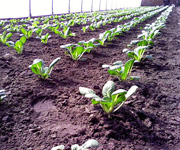Geophysical Sciences course has students gathering hard numbers on transporting regional produce
By Steve Koppesskoppes@uchicago.edu
News Office
|
|||
Chicago and a growing list of other cities have adopted green initiatives designed to foster more investment in local and regional agriculture. City officials and citizens alike assume that by doing so they can help soften climate change by cutting greenhouse-gas emissions.
“They just assume,” said Pamela Martin, ‘We’re not transporting the food as far. Let’s subtract those miles and that’s the difference.’ But it’s not that simple,” added Martin, Assistant Professor in Geophysical Sciences and the College. “There are a lot of qualitative ideas about this and some intuition, but not a lot of hard numbers.”
In January, Martin launched a yearlong course to get those numbers. Titled, “Feeding the City: The Urban Food Chain,” the course doubles as a research project. A portion of the course consists of a paid internship for 12 of the students, who will spend the summer working and collecting data at an urban or rural small farm.
“They’re responsible for communicating with the farmer during this whole time, helping them keep records, because this is all about record-keeping,” Martin said. Her team of undergraduates from a variety of disciplines will document all farm inputs, both direct and indirect (fuel and seed consumption, for example) and output (yield).
Six other students will supplement the interns’ work. Their tasks will range from collecting data about the farms’ locations and distribution networks—right down to the size of trucks used to transport their food into the city—to evaluating the relevant research literature.
The students also will be learning in detail about farming practices and what farmers are up against in terms of making environmentally sound decisions and remaining viable.
Martin’s goal is to establish baseline data on the environmental impact of local agriculture. “Is it just as or more energy efficient than conventional agriculture? If so, let’s use that knowledge when we are putting policies in place. Or is it not even as efficient? And if not, can we improve its energy efficiency?”
Martin divides her research between studying the impact of dietary choices and food production on global warming, and identifying patterns of climate change over hundreds of thousands of years.
In 2006, she co-authored a study showing how the food that people eat is just as important as what kind of cars they drive when it comes to greenhouse-gas emissions, which include carbon dioxide and methane. In doing that study, she realized that a piece of the puzzle was missing: what are the environmental impacts of local, regional or sustainable agriculture as compared to conventional farming practices?
“We’re trying to calculate energy efficiency from food grown in this way, and also look at the greenhouse-gas emissions,” Martin said. “As the study progresses, we hope to use the data we collect to develop new environmental metrics.”
The farms participating in the project each raise a diversity of crops, hundreds of varieties. Traditional farms, by contrast, usually grow only one or two crops and varieties.
Of the six participating rural farms, two are in Wisconsin, one is in Prairie Crossing (in Chicago’s northwest suburbs), and three are near Kankakee, including Genesis Growers in St. Anne, Ill. These farms were selected based on their size (2 to 45 acres of production), the diversity of crops they grow and having at least some of their products directly marketed to Chicago.
The six urban farms, scattered across Chicago, range from a quarter-acre to 2 acres. They include two initiatives of the Chicago Botanic Garden: Windy City Harvest and Green Youth Farm, along with City Farm and Growing Home.
Collaborating with Martin are two Chicago colleagues, an economist and a law professor. David Weisbach, the Walter J. Blum Professor in Law, and Martin are working together to explore the practicality of a tax-credit system for greenhouse gas emissions related to agriculture.
And Sabina Shaikh, Instructor in Economics and the Social Sciences Collegiate Division, will attempt to establish a relationship between economic factors and environmental efficiency on the farms.
“Farmers can really see their economic viability or their economic efficiency. The environmental impact is not so easy to see,” Martin said. Researchers have the same problem, as Esther Bowen (A.B.,’08) found out when she began working on her senior thesis in environmental studies. Her project: examine how campus dining halls might go about purchasing sustainable foods.
Bowen, a graduate student in Geophysical Sciences and teaching assistant for “Feeding the City,” recruited the farms participating in Martin’s study and coordinates student involvement. For her senior thesis, with Martin as her adviser, she set out to determine what food the dining halls bought, and what they should buy under a sustainable food program.
“Then I realized, no one really knows what ‘sustainable’ means for food in such a situation,” Bowen said. So instead, she examined the carbon impact per unit weight of organic versus locally grown fruits and vegetables, framing a question often faced by environmentally minded consumers when faced with the limited availability of a local, organic option. What would their relative environmental savings be in each case?
With idealized assumptions, transportation wins out, according to her study. On the whole, buying local foods results in greater environmental savings.
“It’s just one metric, and there are a lot of other metrics that need to be investigated,” Bowen said. “If anything, it’s a call for more research.”
![[Chronicle]](/images/sidebar_header_oct06.gif)


